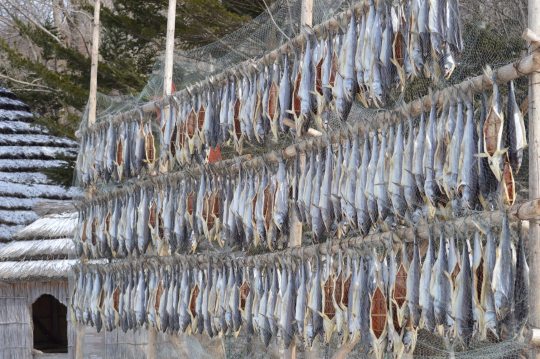FOOD: With the Ainu
Native to Japan’s northernmost island, Hokkaido, the world’s few remaining Ainu people protect an ancient culture, unique to this small corner of the globe. Hunter-gatherers by tradition with a deep reverence for nature, traditional Ainu food is a direct product of Hokkaido’s bountiful landscape.
Read on to discover Japan’s indigenous cuisine.
You’d be forgiven for not having heard of Ainu culture, let alone their food, yet the Ainu people have been residents of Japan’s northern tip for many thousands of years. Today, the Ainu’s diminishing population work hard to preserve their distinct heritage, including a unique food culture that can be credited for influencing many of Japan’s most famous dishes.

Unlike the Japanese who practiced rice farming, the Ainu traditionally hunted, foraged and fished for food, living off the land with a nutrient-rich diet that had a lasting impact on Japanese cuisine. Umami, for example, Japan’s infamous ‘fifth taste’ has its roots in Ainu cooking. Found in fermented foods such as miso and soy, umami is widely associated with Japanese cuisine, yet it can in fact be traced back to the Ainu’s use of kombu – an edible sea kelp which grows in abundance off the coast of Hokkaido. Kombu was adopted directly from Ainu cuisine and is today one of the most prevalent ingredients in Japanese cooking. It even forms the base for dashi – an umami-rich broth and one of Japan’s culinary cornerstones.

The Ainu practice animism, cultivating a deep connection with the natural world. This intrinsic respect for nature forms the foundation of Ainu cooking, and whilst Hokkaido today is best known for fresh seafood and dairy produce, the Ainu ate bear, deer and salmon, foraging wild plants, berries and grasses in-tune with the changing seasons. Living in harmony with the surrounding landscape, the Ainu would only eat what could be found locally, and never over-fished, foraged or hunted, protecting their future by eating sustainably.

Another key distinction between traditional Ainu cuisine and Japanese cooking is that fish or meat is rarely eaten raw, meaning sushi and sashimi are firmly off the menu. Instead, fish or animal meat is boiled into a soup, roasted or dried and preserved to provide food through the winter months. Traditionally, the fish skins and animal hides would then be used to make clothing.

Today the Ainu’s simple, sustainable, super-food rich cuisine is mainly eaten in private homes, though there are a small number of restaurants and cooking schools championing Ainu fare. In Sapporo, Ainu chef Hiroaki Kon opened Kerapirka in 2019 – one of the few Ainu restaurants in the world. In Tokyo, too, Ainu dishes are making their way onto restaurant menus, for examples at Michelin-starred restaurant L’Effervescence lead by chef Shinobu Namae, who aims to give Japan’s indigenous food the recognition it deserves.
Images: Laura Liverani via the Guardian


